
Discontinued
The iPhone 11 Pro came out in September 2019, and while Apple continued to sell the regular iPhone 11 alongside the iPhone 12 lineup introduced in September 2020, the iPhone 11 Pro was discontinued. Our previous iPhone 11 Pro roundup is archived below.
iPhone 11 Pro and Pro Max
Contents
Apple on September 10, 2019, unveiled its latest flagship iPhones, the iPhone 11 Pro and the iPhone 11 Pro Max, which are being sold alongside the more affordable and less feature rich iPhone 11. Apple says that the 5.8-inch and 6.5-inch iPhone 11 Pro and iPhone 11 Pro Max have a new "Pro" moniker because the two devices are designed for users who want the very best smartphone that's available.
Both new iPhones feature Super Retina XDR OLED displays, with the 5.8-inch iPhone 11 Pro offering a 2426 x 1125 resolution and the 6.5-inch iPhone offering a 2688 x 1242 resolution.
The new phones include HDR support, a 2,000,000:1 contrast ratio, and 800 nits max brightness (1200 for HDR). True Tone is included for matching the white balance of the display to the ambient lighting in the room to make it easier on the eyes, as is wide color for more vivid, true-to-life colors.
3D Touch has been eliminated in the iPhone 11 Pro and Pro Max, with Apple instead outfitting the new devices with a similar Haptic Touch feature. Haptic Touch is supported across iOS 13, but it lacks the pressure sensitivity of 3D Touch.
Design wise, the iPhone 11 Pro and iPhone 11 Pro Max look similar to the iPhone XS and XS Max, but come in textured matte finishes available in Gold, Space Gray, Silver, and a never-before-used Apple color: Midnight Green.
Though the 2019 iPhones don't look much different, Apple says they're made from the toughest glass ever in a smartphone and offer improved water resistance (IP68), boosting overall durability. Spatial audio support offers a more immersive sound experience, and Dolby Atmos is supported.
The biggest difference between the iPhone 11 Pro and Pro Max and the previous-generation iPhones is the triple-lens camera setup. Apple's new iPhones feature triple 12-megapixel ultra wide angle, wide angle, and telephoto cameras.
The new ultra wide camera features a 120 degree field of view, allowing for better landscape shots and tight shots that are able to capture more without having to adjust the position of the iPhone. The telephoto lens has a larger f/2.0 aperture that allows it to capture 40 percent more light compared to the iPhone XS.
With the addition of an ultra wide angle camera, the iPhones support 2x optical zoom in, 2x optical zoom out, and digital zoom up to 10x. Dual optical image stabilization is available for the wide angle and telephoto lenses, the True Tone flash is brighter, and the cameras offer next-generation smart HDR to intelligently recognize subjects in frame and relight them for more natural-looking photos that have more detail.
The camera interface on the iPhone 11 Pro and Pro Max has been overhauled with a more immersive experience that lets you see and capture the area outside of the frame using the ultra wide-angle camera if desired.
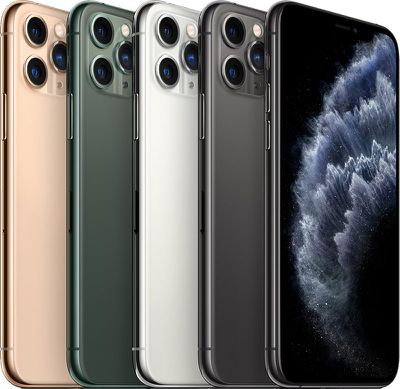
Apple has added a new Night Mode that's designed to use the iPhone's processing capabilities to capture crisp, clear, bright photos even in very low lighting conditions, similar to the Night Sight mode on Google Pixel devices.
When using Portrait Mode, there's an option to choose wide and telephoto framing, enabling Portrait mode with a wider field of view for shots of portraits of multiple people. A new Deep Fusion feature, coming in iOS 13.2, uses advanced machine learning techniques for pixel-by-pixel processing of photos, optimizing for texture, details, and noise.
4K video recording with extended dynamic range is available at 24, 30, or 60fps, and all of the cameras can be used for recording video, with live swapping available.

A QuickTake video mode lets you hold down on the shutter button to automatically record video with subject tracking, and an Audio Zoom feature matches the audio to the video framing for more dynamic sound.
The front-facing TrueDepth Camera system has been updated with a new 12-megapixel camera, and making Face ID up to 30 percent faster and able to work from more angles. For the first time, it supports 120 fps slo-mo video, allowing users to capture slo-mo selfies, aka "slofies." The TrueDepth camera also supports next-generation smart HDR for more natural-looking photos and it can record 4K video at 60 fps.
Inside, there's an A13 Bionic 7-nanometer chip along with a third-generation Neural Engine. Apple says the A13 Bionic is the fastest chip ever in a smartphone with 20 percent faster CPU and GPU than the A12.
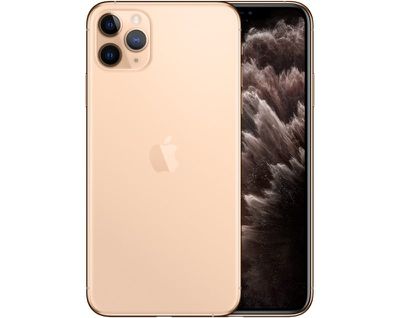
New Machine Learning Accelerators allow the CPU to deliver more than 1 trillion operations per second, and the Neural Engine is faster than ever for real-time photo and video analysis.
When it comes to battery life, Apple has made impressive improvements. The iPhone 11 Pro offers up to 18 hours of video playback, 11 hours of streamed video playback, and 65 hours of audio playback, which is four hours longer than the iPhone XS.
The iPhone 11 Pro Max offers up to 20 hours of video playback, 12 hours of streamed video playback, and up to 80 hours of audio playback, which is five hours longer than the XS Max.
Apple is including an 18W USB-C adapter and a USB-C to Lightning cable in the box with the iPhone 11 Pro and Pro Max, allowing for fast charging speeds. With fast charging, the iPhone can charge to 50 percent within 30 minutes.
The iPhone 11 Pro and Pro Max feature Intels modems with Gigabit-class LTE, 4x4 MIMO, and LAA for speeds up to 1.6Gb/s, Wi-Fi 6 support (802.11ax), Bluetooth 5.0, Dual-SIM with eSIM, and an Apple-designed U1 Ultra Wideband chip that improves spatial awareness and allows for better indoor tracking. In iOS 13.1, the chip allows for directionally aware suggestions for AirDrop.
Apple is offering the iPhone 11 Pro and Pro Max in 64, 256, and 512GB storage capacities with prices that start at $999 for the 11 Pro and $1099 for the larger Pro Max.
Apple is selling the iPhone 11 Pro and the iPhone 11 Pro Max alongside the iPhone 11, a $699 iPhone that's a successor to the iPhone XR. The iPhone 11 has an LCD display instead of an OLED display, a range of colors (including new lavender and mint green shades), and a dual-lens camera, but is otherwise similar in specs to the iPhone 11 Pro with A13 chip, Ultra Wideband support, and more.
Note: See an error in this roundup or want to offer feedback? Send us an email here.
Pricing and Availability
The iPhone 11 Pro and 11 Pro Max are available from the Apple online store, Apple retail locations, and third-party retailers, with orders shipping out within just a few days.
The iPhone 11 Pro is priced starting at $999 for the 64GB model, with a 256GB model available for $1149 and a 512GB model available for $1349. With the Apple Upgrade Program, pricing on the 11 Pro starts at $41.62 per month.

The iPhone 11 Pro Max is priced starting at $1099 for the 64GB model, with a 256GB model available for $1249 and a 512GB model available for $1449. With the Apple Upgrade Program, pricing on the iPhone 11 Pro Max starts at $45.79 per month.
Reviews
Reviews for the iPhone 11 Pro have been largely positive, with reviewers praising the new triple-lens camera system, which is a huge improvement over the camera in the iPhone XS and XS Max.
Night mode especially has received high praise as it allows for crisp, clear photos even in poor lighting. Reviewers have also noted the incredible battery life of the 11 Pro and Pro Max, which last for hours longer than the XS and XS Max.
Aside from the triple-lens camera and the longer battery life, the iPhone 11 Pro and 11 Pro Max have been described as iterative updates over the previous-generation iPhones.
Reviewers generally agree that the new devices are ideal for those who are heavily invested in iPhone photography or those who have an older iPhone, but the upgrade may not be worth the money if you have an XS or XS Max.
Make sure to check out our iPhone 11 Pro review roundup for more information on the new iPhones if you're considering a purchase.
Design
When it comes to design, the iPhone 11 Pro and 11 Pro Max are identical to the iPhone XS and XS Max, measuring in at 5.8 and 6.5 inches, respectively, with full-screen OLED displays than stretch from edge to edge and top to bottom with minimal bezels.
A notch at the front houses the TrueDepth camera system, front speakers, and other sensors, but other than the notch and a slim bezel that wraps around the side of each device, the iPhone 11 Pro and 11 Pro Max are all display.
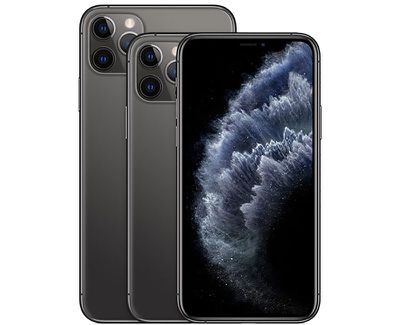
The rounded corners of each display flow into a body made from a new matte glass material that is encased by a durable stainless steel frame, an upgrade from the aluminum frame in the iPhone 11. Apple designed the steel frame from an alloy created to match the body color, with nearly invisible antenna bands at the top and bottom.
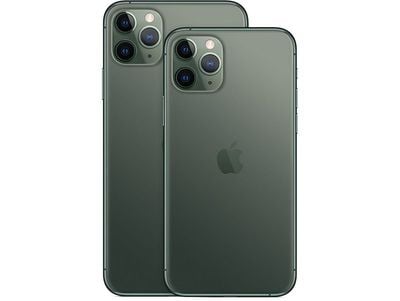
There is no Home button, no bottom bezel, and no Touch ID fingerprint sensor, with the two devices using Face ID for biometric authentication purposes. The left side of the iPhone 11 Pro and Pro Max houses a standard mute switch and volume buttons, while the right side features a side button that doubles as a power button.
From the front, the iPhone 11 Pro and Pro Max don't look different than the XS and XS Max, but Apple made some major changes to the back of the device. There's now a large square-shaped camera bump that houses three lenses arranged in a triangle shape with a flash and microphone nearby.
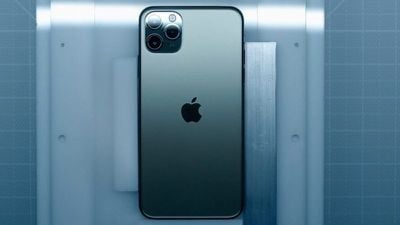
The camera bump is made from the same glass material as the iPhone and it flows right into the body of the device, but the three lenses do protrude and it is a noticeable change as it's much larger than the previous dual-lens camera bump from the XS and XS Max.

Both the iPhone 11 Pro and the 11 Pro Max are a bit thicker and a bit heavier than their predecessors to account for the new triple-lens camera system.
The iPhone 11 Pro measures in at 144mm tall, 71.4mm wide, and 8.1mm thick. It weighs 188 grams. Comparatively, the iPhone XS was 143.6mm tall, 70.9mm wide, and 7.7mm thick, weighing in at 177 grams.
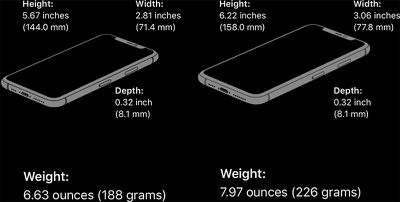
The iPhone 11 Pro Max measures in at 158mm tall, 77.8mm wide, and 8.1mm thick. It weighs 226 grams. The iPhone XS Max was 157.5mm tall, 77.4mm wide, and 7.7mm thick. It weighed in at 208 grams, so the iPhone 11 Pro Max is the heaviest iPhone Apple has released.
Colors and Finish
The iPhone XS and XS Max had a glossy finish, but for the iPhone 11 and 11 Pro, Apple implemented a matte finish that looks more like a brushed glass.

There are four colors this year: Silver, Space Gray, Gold, and Midnight Green. Midnight Green is a new color that Apple hasn't ever used before, and it's a deep, forest green shade that was made possible by ink techniques created by Apple supplier Seiko Advance.
Durability
The iPhone 11 Pro is made from the most durable glass ever in a smartphone, so in theory, it should hold up better to accidental bumps, drops, scratches, and other minor damage. It's still glass, though, so it's best to use a case or have AppleCare+ in case of accidental damage.
Apple says a "dual ion-exchange process" was used to strengthen the front and back glass to make it more durable than prior models.
Water and Dust Resistance
The iPhone 11 Pro, like the prior-generation iPhone XS, has an IP68 water resistance rating, but it is more water resistant. It is rated to survive a depth of four meters (13 feet) for up to 30 minutes, which is an improvement over the two meter rating in the XS and the two meter rating in the current iPhone 11.
In the IP68 number, the 6 refers to dust resistance (and means the iPhone 11 Pro can hold up to dirt, dust, and other particulates), while the 8 pertains to water resistance. IP6x is the highest dust resistance rating that exists.
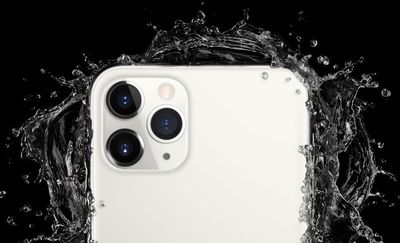
With an IP68 water resistance rating, the iPhone 11 Pro can withstand splashes, rain, and brief accidental water exposure, but intentional water exposure should be avoided if possible. Apple warns that water and dust resistance are not permanent conditions and deteriorate as a result of normal wear.
Apple's warranty does not cover liquid damage to iOS devices so it's best to use caution when exposing the iPhone 11 Pro to liquids.
Spatial Audio and Dolby Atmos
The iPhone 11 Pro is built with a new spatial audio feature that's designed to simulate surround sound for a more immersive audio experience. It also supports Dolby Atmos sound.
Display
The iPhone 11 Pro and iPhone 11 Pro Max use a "Super Retina" XDR display, which Apple says is its best display ever in an iPhone. The Super Retina display features support for Dolby Vision, HDR10, and wide color gamut for unparalleled color accuracy.
The Super Retina display features vivid, true-to-life colors, deeper blacks, and, new this year, a 2,000,000:1 contrast ratio, up from 1,000,000:1.

Compared to a traditional LCD display, such as the display in the iPhone 11, the iPhone 11 Pro is noticeably higher quality, especially when it comes to highlights and shadows. Blacks are blacker, whites are whiter, and everything just looks more realistic and like it does in real life.
Maximum brightness has been improved in the iPhone 11 Pro models, with 800 nits max brightness in typical use (up from 625 nits) and 1200 nits max brightness for HDR.
True Tone support is included, allowing the iPhone's ambient light sensor to adjust the white balance of the display to match the ambient lighting in a room, cutting down on eyestrain for a more paper-like reading experience.
The iPhone 11 Pro, which has a 5.8-inch display, features a resolution of 2436 x 1125 at 458 ppi, while the 6.5-inch iPhone 11 Pro Max features a resolution of 2688 x 1242 at 458 ppi. Apple's newest display is 15 percent more power efficient, which contributes to some impressive battery life gains in the iPhone 11 Pro models.
The iPhone 11 Pro Max has received the highest grade ever for a display from testing and calibration firm DisplayMate. DisplayMate says the iPhone 11 Pro Max offers "considerably better display performance than other competing smartphones."
Haptic Touch
3D Touch, a feature that's been available in iPhones since the iPhone 6s, has been eliminated in the entire 2019 iPhone lineup. The iPhone 11, iPhone 11 Pro, and iPhone 11 Pro Max all use a new Haptic Touch feature, which was first introduced in the iPhone XR.
Haptic Touch is similar to 3D Touch and offers much of the same functionality, but it is not pressure sensitive so there are not multiple functions for each press. Instead, Haptic Touch is like a long press with haptic feedback.
Haptic Touch is able to be used in many of the same places that had 3D Touch support, so most users are not losing features with the exception of the pressure-based feedback. For more on the difference between Haptic Touch and the previous 3D Touch, make sure to check out our Haptic Touch guide.
A13 Bionic Processor
An updated, next-generation A13 Bionic chip powers the iPhone 11 Pro and Pro Max. The A13 Bionic is faster and more efficient than the A12 Bionic chip in the previous-generation iPhones, and according to Apple, it is the fastest chip ever used in a smartphone.

The two performance cores in the A13's CPU are up to 20 percent faster and use 30 percent less power than the A12, and the four efficiency cores are up to 20 percent faster and use up to 40 percent less power.
The GPU in the A13 is 20 percent faster than the GPU in the A12 and it uses 40 percent less power.
According to testing by AnandTech, the A13 in the iPhone 11 and 11 Pro offers 50 to 60 percent higher sustained graphics performance than the iPhone XS and 20 percent faster CPU performance.
Neural Engine
The A13 chip features a next-generation 8-core Neural Engine that Apple says is faster than ever for real-time photo and video analysis. A pair of Machine Learning Accelerators allow the CPU to run up to six times faster, delivering more than 1 trillion operations per second.
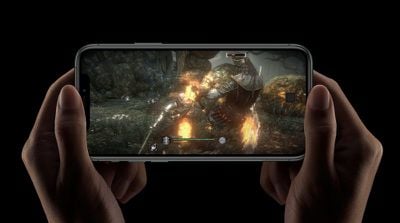
The Neural Engine is up to 20 percent faster and uses up to 15 percent less power than the previous-generation Neural Engine. Apple says its Neural Engine powers the camera system, Face ID, AR apps, and more.
Core ML 3 for developers allows apps to leverage the power of the A13 Bionic for apps and games.
RAM and Storage Space
The iPhone 11 Pro and Pro Max appear to have 4GB of RAM that's available to apps and the iOS system, but it is unclear if there is extra RAM that's dedicated to the camera as rumors have been mixed. We'll need to wait for more information to determine just what's inside.
Leaked benchmarks have indicated that there's 4GB RAM in the two devices, but benchmarks are able to be faked. A leak from a Chinese source has said there's 6GB, but it won't be long before we know for sure.
As for storage space, the iPhone 11 Pro and Pro Max are available in 64, 256, and 512GB capacities.
TrueDepth Camera and Face ID
The iPhone 11 Pro and Pro Max are equipped with Face ID, the facial recognition biometric authentication system that Apple has been using since 2017. Face ID components are housed in the True Depth camera system in notch on the front of the iPhone.
Apple in the iPhone 11 Pro and Pro Max has introduced an updated TrueDepth camera system that uses new hardware. It's 30 percent faster than before at unlocking the device and authenticating passwords and purchases, plus it is designed to work from a wider range of angles.
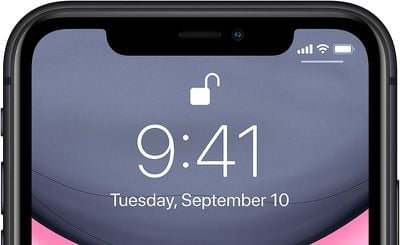
Face ID is used across iOS for tasks like unlocking your iPhone, allowing access to third-party passcode-protected apps, confirming purchases in iTunes and the App Store, and authenticating Apple Pay payments.
Face ID works through a set of sensors and cameras built into the TrueDepth camera system in the iPhone 11 Pro and Pro Max. To create a 3D facial scan that maps the curves and planes of each unique face, a Dot Projector projects more than 30,000 invisible infrared dots onto the surface of the skin, which are then read by an infrared camera.
This facial depth map is then relayed to the A13 Bionic processor where it is transformed into a mathematical model that the iPhone uses to make sure it's you attempting to access your iPhone.
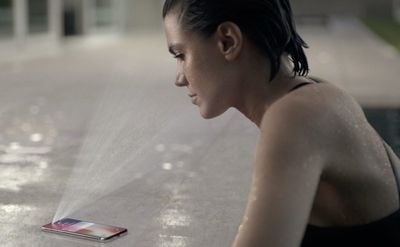
Face ID uses infrared, so it works in low light and in the dark, with a built-in Flood Illuminator making sure there's always adequate light to take a facial scan. Face ID works with hats, beards, glasses, sunglasses, scarves, makeup and all other accessories and items that might partially obscure a face, but it does need to see your eyes, nose, and mouth to work.
The A13 Bionic chip with built-in Neural Engine means that Face ID can adjust to minor facial changes over time, so if you grow your hair longer or grow a beard, Face ID adjusts and continue to unlock your iPhone.
Face ID Security and Privacy
Face ID uses a detailed 3D facial scan that's unable to be fooled by a photo, mask, or other facial imitation. An "Attention Aware" security feature allows Face ID to unlock your device only when you look in the direction of the iPhone 11 Pro with your eyes open, so it does not work when your eyes are closed, when you're sleeping, when you're unconscious, or when you're looking away from your phone.
Attention aware is optional and there is an accessibility feature to turn it off for those who are unable to focus on the iPhone's screen, but most people should leave it turned on for the added layer of security.
With the attention aware feature, the iPhone 11 Pro knows when you're looking at it. Face ID displays notifications and messages on the Lock screen when you look at the iPhone 11 Pro, it keeps the screen lit, and it automatically lowers the volume of an alarm or ringer when it knows your attention is on the iPhone 11 Pro's display.
Face ID data is encrypted and stored in the Secure Enclave on the iPhone 11 Pro. Apple can't access your Face ID data, nor can anyone who has your phone. Authentication happens entirely on your device, with no Face ID data ever stored in the cloud or uploaded to Apple. Third-party developers do not have access to the facial map that Face ID uses to unlock a device, but the TrueDepth camera can be used to scan a user's face for the purpose of creating more realistic augmented reality apps.
With Face ID, there's a 1 in 1,000,000 chance that someone else's face can fool Face ID, but the error rate increases to 1 in 1 in 500,000 with an alternate appearance registered in iOS 13. Face ID has been fooled by identical twins, children, and a carefully crafted mask, but it's still secure enough that the average person shouldn't worry about their iPhone being unlocked by someone else.
TrueDepth Camera Specs
The TrueDepth camera system, in addition to powering Face ID, includes a standard front-facing camera that can be used for selfies.

In the iPhone 11 Pro, the front-facing camera has been upgraded to 12 megapixels from 7 megapixels in the iPhone XS, and it supports next-generation Smart HDR for better than ever contrast and color. The updated camera is capable of recording 60 fps video in 4K with support for extended dynamic range video at 30 fps.
When you take a selfie with the iPhone 11 Pro in standard portrait orientation, it uses a zoomed in 7-megapixel version. Turning your iPhone to landscape mode allows more into the frame and results in a 12-megapixel photo, as does tapping the little arrow icon to zoom out when in portrait orientation.
When using the new front-facing camera, you can turn the iPhone 11 Pro from portrait mode to landscape mode to zoom out to automatically capture more in the frame, which is useful for situations like group selfies or when you want to capture more of what's behind you in a selfie.
Slofies
The front-facing TrueDepth camera is able to capture 120 fps slo-mo videos for the first time, enabling a new feature that Apple is calling "Slofies." These are slow motion front-facing camera videos similar to the slo-mo videos available from the rear facing camera in prior iPhones.
Animoji and Memoji
The TrueDepth Camera System supports two features called "Animoji" and "Memoji," which are animated, 3D emoji characters that you control with your face. Animoji are emoji-style animals, while Memoji are customizable, personalized avatars that you can create.
To enable Animoji and Memoji, the TrueDepth camera analyzes more than 50 muscle movements in different areas of the face, detecting movement of the eyebrows, cheeks, chin, eyes, jaw, lips, eyes, and mouth.
All of your facial movements are translated to the Animoji/Memoji characters, letting them reflect your expression and emotion. Animoji and Memoji can be shared with friends and used in the Messages and FaceTime apps.
There are more than a dozen different Animoji to choose from, modeled after existing emoji characters: mouse, octopus, cow, giraffe, shark, owl, warthog, monkey, robot, cat, dog, alien, fox, poop, pig, panda, rabbit, chicken, unicorn, lion, dragon, skull, bear, tiger, koala, t-rex, and ghost. There are an unlimited number of Memoji that can be created to look like you and other people.
As of iOS 13, there are also non-animated Animoji and Memoji stickers that can be used in the Messages app and other areas of the operating system.
Triple-Lens Rear Camera
A triple-lens rear camera, a first for an iPhone, is the hallmark feature in the iPhone 11 Pro and Pro Max. There are telephoto and wide-angle lenses like before, along with a new ultra wide-angle camera lens.

All three lenses are 12-megapixels and the differences between them are detailed below:
Ultra Wide-Angle Camera
12-megapixel sensor
13mm focal length
f/2.4 aperture
5-element lens
120 degree field of view
The ultra wide-angle camera is the right most lens
Wide-Angle Camera
Larger 12-megapixel sensor that lets in more light
f/1.8 aperture
6-element lens
Optical Image Stabilization
100 percent focus pixels
The wide-angle camera is located at the top left of the iPhone
Telephoto Camera
12-megapixel sensor
f/2.0 aperture
6-element lens
Optical Image Stabilization
2x zoom
40% more light capture than in XS
The telephoto camera is the bottom left lens on the iPhone
According to Apple, with the new ultra wide-angle lens, iPhone users can capture up to four times more scene, which is ideal for landscape shots, architecture shots, group portraits, and tons more.
Apple recommends using the ultra wide-angle lens for an "artful perspective" when taking a close up shot, as it offers up unique angles thanks to the short focal length.

Using the three cameras, you can zoom from the telephoto all the way out to the ultra wide-angle lens, allowing for a 4x zoom. That's 2x optical zoom in and 2x optical zoom out, with digital zoom up to 10x also available.

The Camera app interface has been improved with an updated look that displays the entire field of view captured by the ultra wide-angle lens, even when you're taking a telephoto or standard wide-angle shot.
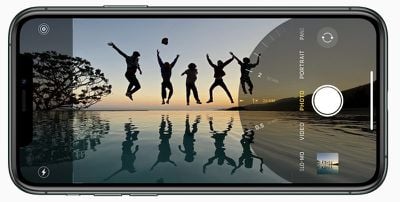
This is designed to let you see what an image could look like if you zoomed out, which you can do with a tap. There is a dedicated button in the camera app for switching between the three available lenses and their different focal lengths so you can get just the shot that you want.
Camera controls for swapping between the three lenses are available no matter what you're doing in the camera app, from taking a photo, video, time lapse image, or slo-mo video.
To make all three cameras work together and function as one, Apple calibrated each camera individually for white balance, exposure, and other metrics. The three cameras are paired and calibrated for module to module alignment, with those calibrations applied to each image in real time.
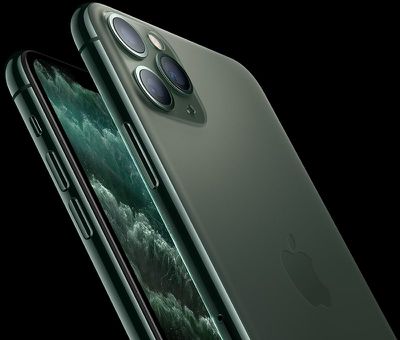
Apple says that capturing an image is like taking raw images from three cameras and processing them for a consistent look and color, with that calculation happening in a split second. This process makes sure your photos look the same, whether you take them with the telephoto, wide-angle, or ultra wide-angle camera.
A next-generation Smart HDR feature is included in the iPhone 11 Pro and Pro Max, using advanced algorithms to bring out highlight and shadow detail in images. It's also able to use machine learning to recognize faces in images, intelligently relighting them for the best possible detail in both the subject and the background.

This is a feature that Apple says even some DSLRs aren't capable of handling.
Night Mode
The wide-angle camera in the iPhone 11 Pro features a larger sensor with 100 percent Focus Pixels to enable new low light capabilities like Night Mode, which is designed to take much brighter pictures in low lighting conditions. It's similar to Google's Night Shift mode, lightening up the photo using complex AI software.
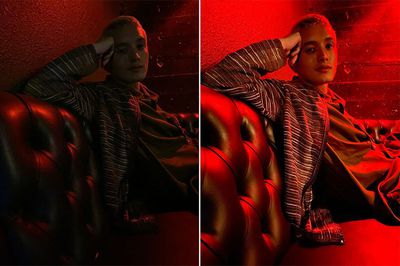
Night Mode turns on automatically in low lighting conditions, and there's no need to use the flash with it. When you're in an area with poor lighting, the camera takes multiple images while optical image stabilization works to steady the lens.
The A13 chip is then engaged to align images to correct for movement. Sections with too much blur are eliminated, while sharper images are fused together. The contrast is then adjusted, the colors are fine tuned, excess noise is eliminated, and details are enhanced to create a final image that looks much brighter and crisper than the lighting conditions would normally allow for.
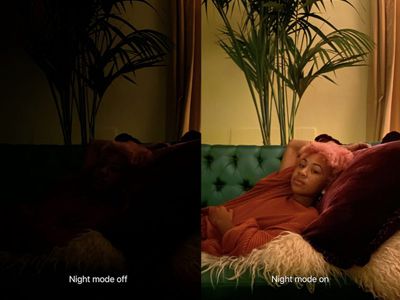
Apple says that users can experiment with manual controls in Night Mode to get even more detail and less noise if desired, so you can get just the look you're going for even in situations where the lighting is far from ideal.
Portrait Mode
Portrait Mode in the iPhone 11 Pro models allows for photos that are focused on a subject in a foreground while the background is blurred.
Portrait Mode has been available since the iPhone X, but in this year's iPhone, Portrait Mode photos can be taken with either the telephoto lens or the wide-angle lens, thanks to the addition of the ultra wide-angle lens, which can be used for depth perception.

In the iPhone X, XS, and XS Max, Portrait Mode was limited to a telephoto focal length. The update means you can take Portrait Mode shots that are more zoomed out and have a wider field of view than before.
Portrait Lighting
The iPhone 11 Pro supports Portrait Lighting, which allows the lighting effects of an image to be shifted using software. There are several different lighting options to choose from, including Natural, Studio, Contour, Stage, Stage Mono, and High-Key Mono.
As of iOS 13, Portrait Lighting effects can also be adjusted using an intensity slider, making them more useful because more subtle looks can be achieved.
Other Camera Features
Other available camera features include a 36 percent brighter True Tone flash, 63-megapixel panoramas that can be twice as high, wide color capture, Live Photos support, advanced red-eye correction, and burst mode.
In iOS 13.2, Apple added a Deep Fusion feature, which is a new image processing system that uses the A13 Bionic and the Neural Engine. Deep Fusion uses advanced machine learning techniques to do pixel-by-pixel processing of photos, optimizing for texture, details, and noise in each part of the image.
Deep Fusion is aimed at improving indoor photos and photos taken in medium lighting. It's a feature that activates automatically based on the lens being used and the light level in the room rather than being something that can be manually enabled.
Camera Tutorials
How to Improve Photo and Video Composition Without Cropping on iPhone 11 and iPhone 11 Pro
How to Select Camera Aspect Ratio on iPhone 11, iPhone 11 Pro, and iPhone 11 Pro Max
How to Take Photos Using Night Mode on iPhone 11, iPhone 11 Pro, and iPhone 11 Pro Max
How to Use the New Camera Lenses on the iPhone 11, iPhone 11 Pro, and iPhone 11 Pro Max
How to Access the Camera Timer on iPhone 11 and iPhone 11 Pro
How to Quickly Shoot Video Using QuickTake on iPhone 11 and iPhone 11 Pro
How to Take Burst Photos on iPhone 11, iPhone 11 Pro, and iPhone 11 Pro Max
How to Switch Focal Lengths in Portrait Mode on iPhone 11 Pro and iPhone 11 Pro Max
How to Use Camera Filters on iPhone 11, iPhone 11 Pro, and iPhone 11 Pro Max
How to Take a Slo-mo Selfie or 'Slofie' on iPhone 11, iPhone 11 Pro, and iPhone 11 Pro Max
For more on what's new with the iPhone 11 and iPhone 11 Pro cameras, make sure to check out our dedicated camera features guide.
Video Capabilities
Apple says that the iPhone 11 Pro and Pro Max offer the highest-quality video in any smartphone. The telephoto, wide-angle, and ultra wide-angle lenses both work in video mode as well, and you can toggle between them with a tap when filming.
The iPhone 11 Pro shoots 4K video at 60 frames per second with both lenses, and the ultra-wide camera can capture four times more scene for better action shots.
The iPhone 11 Pro supports Extended Dynamic Range when capturing video up to 60 frames per second, and optical image stabilization is available for video shot using the standard wide-angle camera.
An Audio Zoom feature is designed to match audio to the video framing for better sound when filming a video on the iPhone.
QuickTake
A new feature called QuickTake lets you take video by holding down the shutter when in photo mode, so you can capture a moment without the need to swap from standard camera mode over to video mode.
When shooting outdoors, the A13 Bionic is able to use machine learning to automatically track a moving subject when QuickTake mode is engaged.
In QuickTake mode, you can swipe right to keep the recording going even longer without having to hold down the shutter button, or swipe to the left to take a series of burst photos, which is ideal for capturing action shots.
Battery Life
With the combination of the A13 Bionic chip, improvements to the Super Retina XDR display, and a new Apple-designed power management unit, Apple has introduced some impressive battery life improvements in the iPhone 11 Pro and Pro Max. In fact, Apple says it's the most dramatic leap in battery life in an iPhone so far.
The battery in the iPhone 11 Pro lasts for up to four hours longer than the battery in the iPhone XS, and the battery in the iPhone 11 Pro Max lasts for up to five hours longer than the battery in the iPhone XS Max.
When it comes to actual usage, the iPhone 11 Pro can last up to 18 hours when playing videos, up to 11 hours when streaming video, and up to 65 hours when playing audio. The iPhone 11 Pro Max can last for up to 20 hours when playing videos, up to 12 hours when streaming videos, and up to 80 hours when playing audio.
The batteries in the iPhone 11 Pro and Pro Max are both heavier and thicker than those used in the XS and XS Max. The iPhone 11 Pro has a 3,046 mAh battery, up from the 2,658 mAh battery in the iPhone XS. The iPhone 11 Pro Max has a 3,969 mAh battery, up from the 3,174 mAh battery in the iPhone XS Max.
iOS 13's Dark Mode appears to offer some battery saving functionality in OLED iPhones, and in testing, an iPhone XS Max used in Dark Mode used less battery than an iPhone XS Max using Light Mode.
According to an Apple support document, the iPhone 11 models are equipped with a new hybrid software and hardware system for performance management, which is more advanced than the battery and power management systems on older iPhones.
Apple says the feature works to provide the "best possible performance as battery aging occurs over time." The power needs of the new iPhones are dynamically monitored, with performance managed in real time.
Fast Charging
Fast charging, an iPhone 11 Pro and Pro Max feature, allows the iPhones to charge to 50 percent power from dead in just 30 minutes using a higher power charger.
For the first time, Apple is including the hardware needed for fast charging with the iPhone, so the iPhone 11 Pro and Pro Max charge up faster than ever.

Each new iPhone ships with an 18W USB-C power adapter, which Apple has previously shipped with iPads, and a USB-C to Lightning cable. Fast charging isn't limited to the iPhone 11 Pro and Pro Max as it's also in the iPhone 11, but these are the only iPhones that come with the necessary hardware right out of the box.
Wireless Charging
The iPhone 11 Pro has a glass body with built-in wireless charging coils to support wireless charging functionality.
Apple uses the Qi wireless charging standard that's also available in many Android phones, which means the new iPhones can charge wirelessly with any Qi-certified inductive charger.
The iPhone 11 Pro works with 7.5W and 5W wireless charging accessories, but 7.5W charging is faster. Multiple companies have now developed wireless charging options designed specifically for Apple's iPhones. Some 7.5W chargers are no longer charging at 5W on the iPhone 11 and 11 Pro, which is worth noting for anyone thinking of making a wireless charger purchase.
Connectivity
Gigabit-Class LTE
LTE in the iPhone 11 Pro and 11 Pro Max is faster than ever thanks to the inclusion of Gigabit-class LTE with 4x4 MIMO and LAA. 4x4 MIMO and LAA are different LTE technologies that use multiple antennas, multiple data streams, and unlicensed spectrum paired with licensed spectrum to boost LTE speeds up as fast as possible.
The iPhone 11 Pro and 11 Pro Max have the most advanced LTE technologies in an iPhone, with the cheaper iPhone 11 also offering Gigabit LTE but limited to 2x2 MIMO. Though the two new iPhones feature faster maximum LTE capabilities, there is no support for 5G and the they won't work with 5G networks. Both the iPhone 11 Pro and Pro Max are equipped with Intel modems.
When it comes to LTE bands, the new iPhones support up to 30, which is useful when traveling. Different countries use different LTE bands, so with more LTE band support, there's a better chance that your iPhone is compatible with local LTE networks when you travel.
Dual-SIM Support
Dual-SIM support, which allows two phone numbers to be used at one time, is included in the iPhone 11 Pro and Pro Max. Dual-SIM functionality is enabled through the inclusion of one physical nano-SIM slot and an eSIM.
The eSIM feature is available in many countries around the world, and Apple has a full list of carriers that support eSIM on its website.
Dual-SIMs work with select carriers in Austria, Canada, Croatia, Czech Republic, Germany, Hungary, India, Spain, the UK, and the United States.
Ultra Wideband
The iPhone 11 Pro models feature a new Apple-designed U1 chip that enables Ultra Wideband technology for improved spatial awareness. The chip lets the iPhone 11 precisely locate other U1-equipped Apple devices, which is ultimately going to make it easier to find a device that's lost.
Apple likens Ultra Wideband to "GPS at the scale of the living room," which is accurate as the technology is designed specifically for improved indoor positioning.
One example of how Apple is using the U1 chip is AirDrop. Apple says you can just point your iPhone at someone else's iPhone and their device shows up first on your list of AirDrop targets. This feature is set to launch in iOS 13.1.
Bluetooth and WiFi
The iPhone 11 Pro supports Bluetooth 5.0. Bluetooth 5.0 offers longer range, faster speeds, larger broadcast message capacity, and better interoperability with other wireless technologies.
Compared to Bluetooth 4.2, Bluetooth 5 offers four times the range, two times the speed, and eight times the broadcast message capacity.
WiFi 6 with 2x2 MIMO, aka 802.11ax WiFi, is supported. WiFi 6 is the newest WiFi protocol and it lets you download up to 38 percent faster than WiFi 5 (aka 802.11ac). WiFi 6 is a new WiFi protocol and it's not widely used at this time, but support will become increasingly important over the course of the next few years.
GPS and NFC
Support for GPS, GLONASS, Galileo, and QZSS location services is included in the iPhone 11 Pro and Pro Max.
NFC with reader mode is included, and there's a background tag feature that allows the iPhone models to scan NFC tags without the need to open an app first.
iPhone 11 Pro How Tos
iPhone 11
Apple is selling the iPhone 11 Pro and Pro Max alongside the iPhone 11, a much more affordable device priced starting at $699.
The iPhone 11 Pro and the iPhone 11 Pro Max are the top-of-the-line iPhones, designed for those who want the most advanced technology in an iPhone, while the iPhone 11 has a few feature compromises to keep the price low.
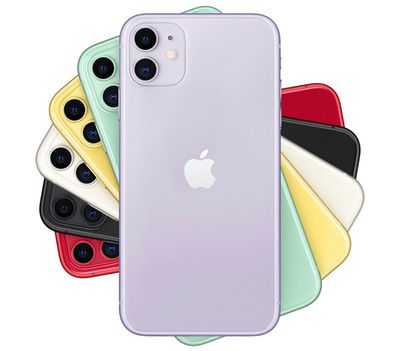
All of the iPhone 11 and 11 Pro models share features like the A13 bionic chip, Face ID, TrueDepth camera system, and some photographic capabilities, but there are some notable differences.
The iPhone 11 Pro and 11 Pro Max feature OLED displays that are superior to the LCD display used in the iPhone 11, with HDR and a much greater contrast ratio for brighter, more vivid colors. The new higher-end iPhones use a stainless steel frame rather than an aluminum frame, and have a better water resistance rating (IP68 at 4 feet rather than IP68 at 2 feet).

Most notably, the iPhone 11 Pro and Pro Max feature a triple-lens camera system with telephoto, wide-angle, and ultra wide-angle lenses, while the iPhone 11 has a dual-lens camera with wide-angle and ultra wide-angle lenses.
You can read more about the features included in the iPhone 11 in our dedicated iPhone 11 roundup.
iPhone 11 vs. iPhone 11 Pro
The iPhone 11 and iPhone 11 Pro share many of the same features, but there are some key differences between the devices as the iPhone 11 is a much more affordable device. Below, we've listed all of the features of the two smartphones, so you can see what's different and what's the same at a glance, and make sure to check out our full comparison guide for more info. We've also included a camera comparison.
What's Different - iPhone 11 (Left) iPhone 11 Pro (Right)
6.1-inch LCD
1792x828 display w/ 326ppi
Dual 12-megapixel cameras (wide and ultra-wide)
Optical Image Stabilization
Aluminum frame
Six colors
Glass body
1 hour longer battery than XR
IP68 water resistance @2ft
Up to 256 GB storage
Gigabit LTE 2x2 MIMO
Ships w/ 5W charger
5.8/6.5-inch OLED HDR displays
2436x1125/2688x1242 display w/ 458ppi
Triple 12-megapixel cameras (wide, ultra-wide, and telephoto)
Dual Optical Image Stabilization
Stainless steel frame
Four colors
Matte glass body
4/5 hour longer battery than XS/XS Max
IP68 water resistance @4ft
Up to 512 GB storage
Gigabit LTE 4x4 MIMO
Ships w/ 18W charger
What's the Same
Haptic Touch
True Tone display support
Wide color display
12-megapixel TrueDepth front-facing camera
Front-facing slo-mo video support
Face ID support
Animoji/Memoji
A13 Bionic chip w/ third-gen Neural Engine
Wireless charging
Fast charging capable
Portrait Mode (front and rear)
Night Mode
Depth Control (front and rear)
Next-Gen Smart HDR (front and rear)
Portrait Lighting
4K 60 fps video recording
QuickTake video recording button
Quad-LED True Tone Flash
Dolby Atmos sound
Bluetooth 5.0
802.11ax WiFi 6 with 2x2 MIMO
Lightning Connector
Dual-SIM support
U1 chip for spatial awareness
iPhone Overview Guide
If you want to see how all of the iPhones in Apple's current lineup compare, make sure to check out our dedicated iPhone guide, which has details on each iPhone along with buying suggestions.

